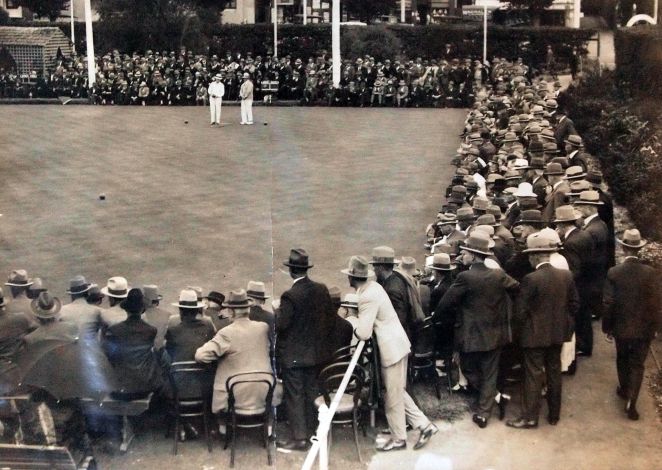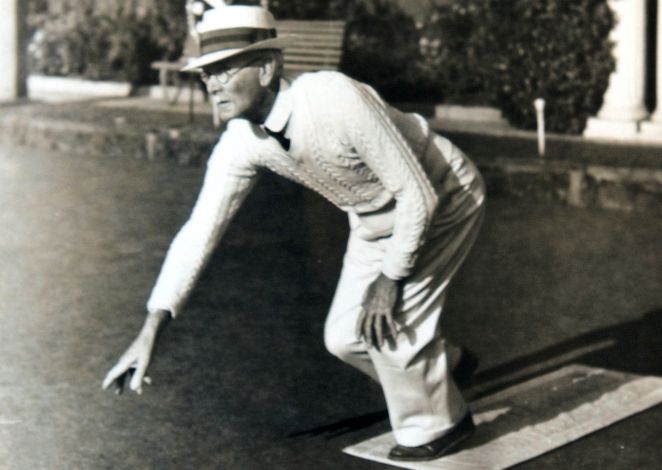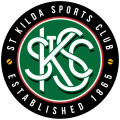HISTORY


The St Kilda Bowling club is of historical significance to the State of Victoria.
The St Kilda Bowling Club was formed at a meeting on 7 June 1865 and a provisional committee was appointed to find a suitable site for the club. E.T. Bradshaw, the town clerk of St Kilda who was also fortuitously the honorary treasurer and honorary secretary of the Bowling Club, wrote to the Board of Lands and Survey requesting him to permanently reserve for the Club a portion of the Alpaca Reserve situated near the railway station with a frontage of 205 feet and a depth equal to the railway reserve.
The reserve had been temporarily placed under the control of the Borough Council of St Kilda and as neither the council nor the Board of Land and Works objected to this proposal, the land was allotted in accordance with the original request. Fifty ratepayers signed a petition objecting to part of the park being appropriated for a bowling green, but predictably, given the composition of the club and the council, the objection was ignored.
The green was laid in June 1865 and a high paling fencing was erected. The green was opened on 11 November 1865 and the event commemorated by the planting of trees. The club rooms at this stage were temporary structures. The club catered for quoits, croquet and skittles in addition to lawn bowls. The club was officially opened by Prince Alfred in January 1868.
The architect Sydney Smith called for tenders on 4 September 1876 to build a pavilion at the St Kilda Bowling Club (known as the Prince Alfred Bowling Club from the royal visit of 1868 until 1882). The pavilion was a timber construction with corrugated iron, jerkin head roof and verandah. The 1876 pavilion survives at the south-western end of the present building complex.
Major additions were made to the pavilion in 1926. The designer is not clear. Mr G.W. Clauscen was reported to have drawn the plans. The Annual Report of 1926-27 notes “the advice and services rendered by…Honorary Architect, S. W. Smith, Esq., during the year.” The addition was a gabled timber structure with a corrugated iron roof.
In 1967-68 approximately one third of the 1926 additions were demolished and replaced with a brick hall with toilets and kitchen at the rear, a bar at one end and a wall of glass overlooking the green. The building permit application identified Rex McDermott as the “Superintending Architect or Engineer” without specifying which one. The Annual Report of 1968-69 names H. Wood as the club’s honorary architect but his name does not appear on the drawings. The cost of the addition was $24,000. (Neale & Sands 1999)
St Kilda Sports Club Inc formerly known as St Kilda Bowling Club (prior to incorporation) has been on the site since 1865.
The St Kilda Bowling Club (known as the Prince Alfred Bowling Club from the Royal visit of 1868 until 1882) was formed in 1865. A part of the land set aside from the remainder of Albert Park as an Alpaca Reserve in 1864, under the control of St Kilda Council, was reserved for bowling club purposes and the 150 foot green was laid and a high paling fencing erected. The green was opened with temporary club rooms on 11 November 1865 and the event commemorated by the planting of trees. The club catered for quoits, croquet and skittles in addition to lawn bowls.
The club started as St Kilda Bowling Club and was formed in 1865, it is the second oldest existing bowls club in Australia. A history of the early days of the Club written by JP Monro was published in the handbook to the sixth Australian Bowling Carnival held in Melbourne in 1927.
The part of the clubhouse that was built in 1876 is the oldest existing bowls clubhouse in Australia, and is listed on the Victorian Heritage Register.
The Club was incorporated in 1987 and in 1993 its name was changed to “St Kilda Sports Club”.
With the dropping out of the old Fitzroy green (in 1927) and the old Prahran (in the early seventies) St Kilda becomes the second oldest existing Club in Victoria , and in Australia. It was formed on the 7th June 1865, and its first President was the Hon A Fraser MLC, with Henry Tullett as first Secretary. An area of land “contiguous to the Melbourne and St Kilda Railway Reserve” was secured from the Boards of Lands and Survey on a permissive occupancy, and steps were taken to lay down a green 150 ft square which was said to be surpassed in size by only 3 greens in Scotland.
The green was opened on the 13 November 1865, with a match between a team chosen by the President and vice President (Dr Patterson), the latter winning, thanks largely to Mr Hocknell, who did great execution with his unbiased bowls in driving away the jack. The opening of the green was commemorated by the planting of trees by those concerned in the establishment of the club. The first interclub match played by this club was against the Melbourne club on 7/4/66, the latter winning. The original intention was to limit the number of members of the club to 100, but the flow was so great that that idea had to be abandoned. There were 140 paid up members in the second season. A croquet lawn was provided for the gentle sex, and was well patronised. It is of interest to note that during the first two seasons the grass was cut with a scythe, and the balance sheet for the 1866-67 season showed that the expenditure had exceeded the receipts by 82 pound one and six, the cause being the large expenditure upon labor required in connection with attention to the turf, but it was considered that the mowing machine which had been ordered would reduce the labor cost considerably.
It was a great day at St Kilda on the 2 January 1868, when his Royal Highness Prince Alfred, the Duke of Edinburgh, visited the bowling green. He was expected to arrive at 11 am, but did not appear until nearly one o’clock, when he drove up with his team of greys. The game was explained to him, and he tried his hand at it, and “as each bowl left the Royal hand the Member’s loud cheers were ready chorus”. He was then taken to plant a tree, which he with difficulty did, for the people – “the females particularly” – crowded so close that the police had a hard job to keep the place clear. The Duke expressed a desire to become an honorary member of the club, which the committee resolved should henceforth be known as the “Royal Alfred Bowling Club”. That title was soon supplanted by the “Prince Alfred Bowling Club”, which was retained until 1882, when the original name of “St Kilda Bowling Club” was reverted to. When the Duke was shot by O’Farrell at Clontarf in March 1868, the members of the club met and passed resolutions expressing their great indignation at the crime, and stating that if the deed had been done on the Prince Alfred green, the members would, in the heat of the moment, had terminated the miscreant’s career in a summary manner.
Strange to say, this old club, during its long life, has rarely been very prominent in the classic events of the bowling world. In 1901 F Ellis was fourth in the MCC single handed championship of Australia, and in 1926 S Pickett was third at the fifth AB Carnival, held at Sydney under the auspices of the ABC. In 1886 R Bowman was runner up for the VBA single handed championship. In 1926 TH Taylor was second in the Champion of Champions. The first VBA pairs championship was won in 1926 by G Marsdon and A F le Couillard, of St Kilda. The Club’s team won the annual trophy in 1879, and was runner up in 1877 and 1886. Its first champion was Henry Tullett, and the present one is G W Clauscen. Councilor Baron Marks is President (for the fifth year), and Arthur J Wells is Secretary.
The St Kilda green consists of 10 rinks, and the playing sward is of the best. It has been the source of many important fixtures. The length of the green was reduced from 150 ft to 120 ft in 1925, after many years of resistance, to the standard length. The club premises were extended in 1926, and they are now very commodious and complete in all arrangements. The green has the electric light installed. Among those prominently identified with the Club in the years gone by may be mentioned Sir George Turner, (formerly Premier of Victoria and Commonwealth Treasurer) and Sir Henry Galway (Governor of South Australia). The work of WT Marshall during his fifteen years of secretaryship, must not be overlooked in this necessarily brief review. The Prince Alfred Club was one of the foundation clubs of the Victorian Bowling Association in 1880; and it was a member of the Conference which on 4/7/1867 framed the uniform laws of the Game of Bowls for the Victorian Clubs.”


